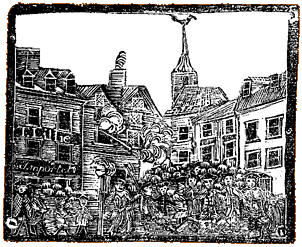The Autopsy of Christopher Seider
 This week Boston 1775 will take the theme of CSI: Colonial Boston. I could probably come up with a few clever allusions to the CSI television shows if I’d watched more than a snippet of them, but you’ll have to provide those parallels yourselves. I’ll just quote documents about investigating dead bodies in Revolutionary Massachusetts.
This week Boston 1775 will take the theme of CSI: Colonial Boston. I could probably come up with a few clever allusions to the CSI television shows if I’d watched more than a snippet of them, but you’ll have to provide those parallels yourselves. I’ll just quote documents about investigating dead bodies in Revolutionary Massachusetts.
First up, little Christopher Seider, died on 22 Feb 1770 in the North End, as reported in the newspapers:
soon after the child’s decease his body was opened by Dr. [Joseph] Warren and others and in it were found eleven shot or plugs, about the bigness of large peas; one of which pierced his breast about an inch and one-half above the midriff and passing clear through the lobe of the lungs, lodged in his back.Good news: young Gore did not lose the use of his hand—at least not enough to prevent him from participating in the Boston Tea Party of 1773 and stealing two cannon from a gunhouse under redcoat guard in 1774. He had a long career as a decorative painter, paint importer, and glass factory owner in the early republic. Throughout his life Gore enjoyed showing off the scars on his fingers from where Richardson had shot him.
This, three of the surgeons deposed before the Jury of Inquest, was the cause of his death; on which they brought in their verdict, wilful murder by [Ebenezer] Richardson. The right hand of the boy was cruelly torn, whence it seems to have been across his breast and to have deadened the force of the shot, which might otherwise have pierced the stomach.
Dr. Warren likewise cut two slugs out of young Mr. [Samuel] Gore’s thighs, but pronounced him in no danger of death, though in all probability he will lose the use of the right forefinger, by the wound received there, much important to a youth of his dexterity in drawing and painting.

2 comments:
Could you please tell me what newspaper this article comes from and the publication date? Thank you in advance!
This article appeared in the Boston Evening-Post on 26 Feb 1770. Other newspapers often reprinted such news verbatim, so the same words appeared in the Boston News-Letter on 1 Mar 1770 and then in more American newspapers later that month.
This transcription (which spells out the word “eleven,” unlike the original) appears in Emil Baensch’s 1924 book A Boston Boy: The First Martyr to American Liberty.
Post a Comment